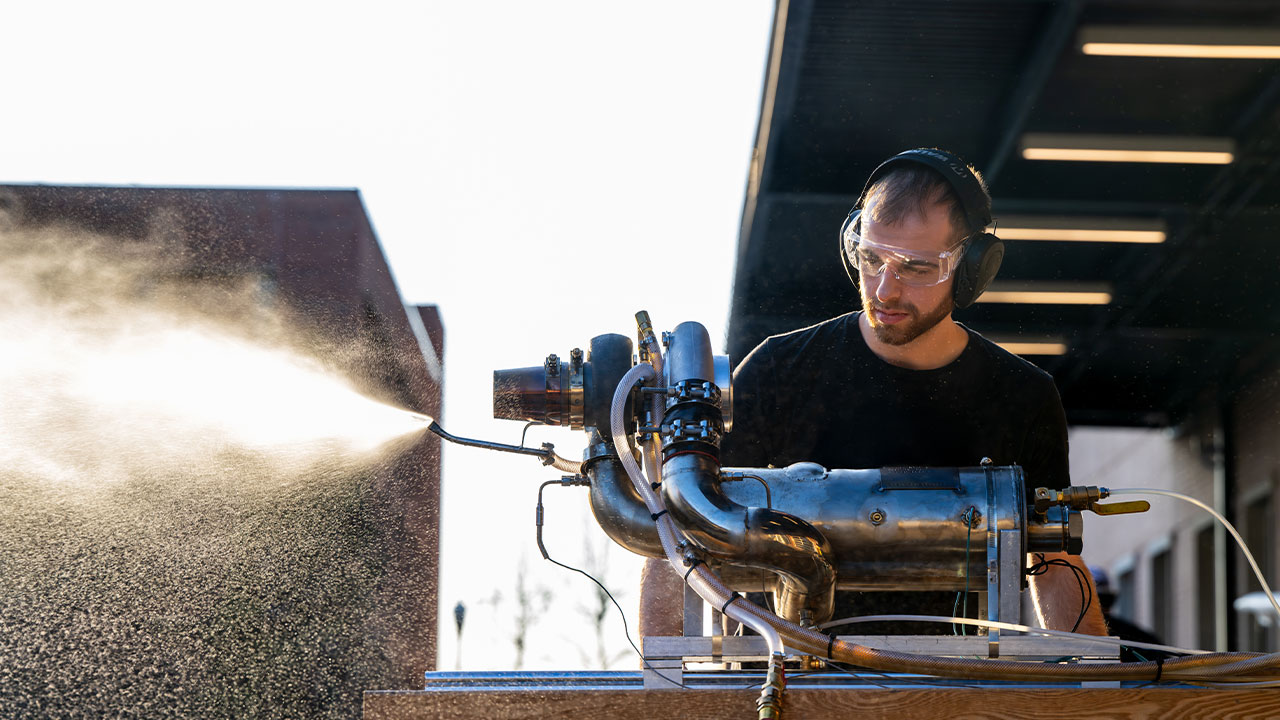content body

The Makerspace provides Auburn engineering students with adequate space and tools to practice their classroom skills by designing and executing whatever they can imagine.
Brandon Barnett explains in a YouTube video how the functional jet engine he built is “quite simple.”
Easy for him to say, but not everyone understands how air, gas and pressure generate the thrust required to move an aircraft forward. Barnett, quite simply, has a mind like an engineer. He thrives on learning how things work and doing projects with custom 3D printing or machining.
Couple that with his interest in aircrafts and space vehicles, it was inevitable a young man from the small town of Jacksonville, Alabama, would find his way to Auburn University and the Samuel Ginn College of Engineering.
Barnett knew he wanted to be an engineer when he was young. He developed a desire to build a jet engine while in high school.
“It has been on the to-do list since then, but I lacked some of the metalworking skills and access to the equipment necessary to accomplish it with the degree of craftsmanship I would want,” he said.
Fortunately for Barnett, he not only learned the skills at Auburn, where he studies aerospace engineering, but the Brown-Kopel Engineering Student Achievement Center is home to the Design and Innovation Center.
Better known as the Makerspace, the 11,000 square feet of prototype, metal, electronics and machine shops provide engineering students with the room to test their classroom skills by designing and executing whatever they can imagine.
Some would say the sky is the limit in the Makerspace.
Walter Gary would agree. Before he graduated in 2024 with an aerospace engineering degree, Gary spent nine months designing and building his own ultralight aircraft in the Makerspace. He also designed and built custom furniture in its wood shop.
What Auburn provides
Barnett has a small shop at his family’s home in Jacksonville, but it’s modest in comparison to the Makerspace, where he said, “The equipment is excellent, and the student workers are helpful and happy to teach others new skills. I think it would be difficult to come up with a project that wouldn't be possible in the Makerspace.”
Student workers, known as Maker Assistants, manage the different shops, perform training and provide guidance to fellow students when needed. Garon Griffiths, a 2003 mechanical engineering alumnus, is the center’s manager.
Predictably, Barnett’s project — from design to testing — drew considerable attention. It’s easy to be curious inside the Makerspace since students can create just about anything — from 3D-printed figurines and wooden coffee tables to rebuilding a car engine and modifying electric guitars.
To investigate the engine’s capabilities, Barnett simply wheeled his workbench outside Brown-Kopel and cranked it up. He has tested the engine numerous times and admitted it would have been impossible for anyone “to ignore even a small jet engine running on campus.”
“It was really fun explaining how it worked and how I went about designing and fabricating it,” Barnett said. “In terms of design, my aerospace curriculum was helpful in understanding fundamentals, but the design was my original work.”
The engine had to undergo quite a bit of testing, according to Barnett, to get it to be “reliable and throttleable.”
“A project like this has too many confounding variables to optimize the design fully without testing and tuning,” he explained. “At this stage, it fires up instantly every time and can be quickly throttled across a wide range of thrust settings, which I am very pleased with.”
Now what? Barnett doesn’t know.
Understandably, he is focused on finishing his last semester of college, as well as an internship with Boeing, while securing a job before graduation in May. Barnett is also developing products for his own company, a manufacturer of mountain bicycle parts.
“This engine has probably been optimized to the extent that is possible without a complete redesign, but who knows, that might just happen, too,” he admitted.









